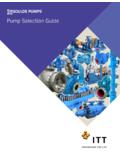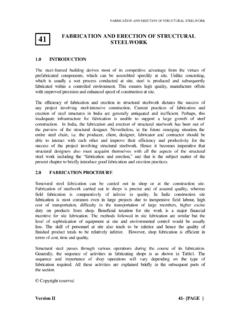Transcription of USE CATEGORY SYSTEM USER SPECIFICATION FOR …
1 U1-21 AMERICAN WOOD PROTEC TION ASSOCIATION STANDARD. 2021 All Rights Reserved U. USE CATEGORY SYSTEM : user SPECIFICATION FOR TREATED WOOD. Adopted: 1999. U1. Revised: 2000, 2001, 2002, 2003, 2004, 2005, 2006, 2007, 2008, 2009, 2010, 2011, 2012, 2013, 2014, 2015, 2016, 2017, 2018, 2019, 2020, 2021. This Standard was developed by AWPA's Technical Committees in an open, consensus-based process. Any modifications, deviations, or exceptions to this Standard invalidate any references to this Standard and nullifies any statements of compliance with this Standard. IMPORTANT: Various Federal, State, and Local regulations may govern the use of products or processes standardized by AWPA. The existence of an AWPA Standard for a product or process does not imply that it is lawfully permitted for use in all potential applications.
2 AWPA Standards are not to rv PA d be regarded as legal or other professional advice. NOTE: The user 's attention is called to the possibility that compliance with this standard may require use of an invention covered by patent rights. By se W dar publication of this standard, no position is taken with respect to the validity of any such claim(s) or of any patent rights in connection therewith. If a patent holder has filed a statement of willingness to grant a license under these rights on reasonable and nondiscriminatory terms and conditions to applicants desiring to obtain such a license, then details may be obtained from AWPA. Re - A an 1. Introduction to the Use CATEGORY SYSTEM B. Posts 2. Service Conditions for Use CATEGORY Designations C.
3 Crossties and Switchties 3. Guide to Commodity Specifications for Treated D. Poles t ed Wood End Uses E. Round Timber Piling ht 02 S. 4. Standardized Preservatives 5. Species and Species Groupings Referenced in AWPA Standards F. G. H. Pressure-Treated Wood Composites Marine (Salt Water) Applications Fire Retardants ig t 2 PA. 6. Management of Used Treated Wood I. Nonpressure Applications Commodity Specifications: 1 J. Non-Pressure Treated Wood Composites A. Sawn Products K. Barrier Protection Systems lR h W. SECTION 1: INTRODUCTION TO THE USE CATEGORY SYSTEM (INFORMATIVE). Jurisdiction: AWPA Technical Committee T-1. Al rig A. The Use CATEGORY SYSTEM (UCS) of the American Wood designation, Standard U1 Commodity SPECIFICATION , wood py om Protection Association (AWPA) designates what preservative species, preservative and any special requirements such as pre- s systems and retentions have been determined to be effective in or post-treatment preparations (including conditioning and protecting wood products under specified exposure drying).
4 Wherever practicable, material should be conditions. The strength of the UCS and its focus is that all manufactured in its final form prior to treatment to eliminate wood uses can be placed into one of five major Use Categories the necessity for subsequent cutting or boring of the treated Co t fr that clearly describe the exposure conditions that specific wood. Risk assessment documents and models ( , Best wood products can be subjected to in service. The major Use Management Practices) have been developed by the Western Categories are further broken down into sub-categories to Wood Preservers Institute ( ) for the use define the associated degree of biodegradation hazard and of CCA, ACZA, Creosote, Pentachlorophenol and ACQ.
5 Pr product service life expectations for specific products and treated wood in aquatic environments. Projects calling for exposure conditions. In addition to the five Use Categories for large volumes of treated wood immersed in ( , below the biodeterioration, there is a sixth and separate Use CATEGORY for splash zone) poorly circulating bodies of water should be ce fire retardant applications. The Use CATEGORY designations are evaluated on an individual basis using risk assessment described in detail in Section 2 below. The Use CATEGORY procedures. There are a number of other AWPA Standards that SYSTEM is designed to help specifiers and product users locate complement Standard U1 for wood treated with preservative Ex the appropriate AWPA Standards that specifies preservatives systems.
6 These include: deemed acceptable for specific products and end-use Standard T1: Use CATEGORY SYSTEM : Processing and environments. The user of the AWPA Standard U1 should first Treatment Standard, that governs the preservative retention become familiar with the major differences between the Use and penetration requirements, processing limitations, quality Categories and the expected service conditions as described in control and inspection requirements for treated wood. Section 2. This information is then used in conjunction with Miscellaneous (M) Standards for quality control and Section 3: Guide to Treated Wood End Uses to determine the inspection items specific commodity SPECIFICATION of the standard that lists the Analytical (A) Standards to determine conformance of appropriate preservative requirements for that use.
7 When preservative systems, penetration, and retention. Refer to the purchasing under the Use CATEGORY SYSTEM , material orders Introduction to this Book of Standards at the front of this should include the specific commodity, Use CATEGORY edition for additional information. U1-21 USE CATEGORY SYSTEM : user SPECIFICATION FOR TREATED WOOD. Page 2 of 72. 2021. SECTION 2: SERVICE CONDITIONS FOR USE CATEGORY DESIGNATIONS. (NORMATIVE/MANDATORY). Jurisdiction: AWPA Technical Committees T-2, T-3, T-4, and T-8. U1. The following is a breakdown of the Use Categories used by AWPA to describe the exposure conditions that wood may be subject to in service. This is also given in table form to summarize the major differences between Use CATEGORY groupings.
8 UC1 INTERIOR/DRY UC4 GROUND CONTACT. rv PA d Wood and wood based materials used in interior construction UC4A GROUND CONTACT General Use (for se W dar not in contact with the ground or foundations. Such products Commodity SPECIFICATION A only) -- Wood and wood-based are protected from weather and interior sources of water such materials (1) used in contact with the ground, fresh water, or as leaking plumbing, condensate, pools and spas. Examples other situations favorable to deterioration; (2) used above are interior furniture, construction furnishings, and millwork. ground but are difficult to maintain, repair or replace and are critical to the performance and safety of the entire SYSTEM Re - A an UC2 INTERIOR/DAMP.
9 /construction; or (3) used above ground but may end up in Wood and wood based materials used for interior construction ground contact or are subject to hazards comparable to that are not in contact with ground, but may be subject to ground contact due to climate, artificial or natural processes dampness. These products are continuously protected from the t or construction. Examples are sawn fence posts, sawn deck ed weather but may be exposed to occasional sources of moisture. ht 02 S. posts, sawn guardrail posts, structural lumber, joists and Examples are interior beams, timbers, flooring, framing, beams for decks and freshwater docks, and timbers located millwork and sill plates. in regions of low natural potential for wood decay and insect ig t 2 PA.
10 UC3 ABOVE GROUND (Exterior) attack. Note 1 (for Commodity SPECIFICATION A only): The UC3A ABOVE GROUND Protected -- Wood and wood- following sawn components for exterior above ground use 1. based materials used in above ground exterior construction shall be treated to Ground Contact UC4A or higher lR h W. that are either (a) exposed to the full effects of weather, but requirements: protected by a coating and constructed such that water will quickly drain from the surface or (b) fully and continuously a) When there is a reasonable expectation that soil, Al rig A. protected by design, construction and maintenance from vegetation, leaf litter or other debris may build up and remain precipitation, including wind-driven rain and splash-back in contact with the component.




